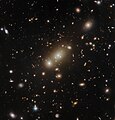File:A clear view of a galaxy cluster (potw2333a).tiff
From Wikimedia Commons, the free media repository
Jump to navigation
Jump to search

Size of this JPG preview of this TIF file: 576 × 600 pixels. Other resolutions: 230 × 240 pixels | 461 × 480 pixels | 738 × 768 pixels | 984 × 1,024 pixels | 1,967 × 2,048 pixels | 3,136 × 3,265 pixels.
Original file (3,136 × 3,265 pixels, file size: 58.62 MB, MIME type: image/tiff)
File information
Structured data
Captions
Captions
The truly massive galaxy cluster 2MASX J05101744-4519179 basks in the centre of this image from the NASA/ESA Hubble Space Telescope. This distant galaxy cluster is a cosmic leviathan that is highly luminous at X-ray wavelengths.
Summary[edit]
| DescriptionA clear view of a galaxy cluster (potw2333a).tiff |
English: The truly massive galaxy cluster 2MASX J05101744-4519179 basks in the centre of this image from the NASA/ESA Hubble Space Telescope. This distant galaxy cluster is a cosmic leviathan that is highly luminous at X-ray wavelengths. Observing galaxy clusters like 2MASX J05101744-4519179 can advance our understanding of the evolution and interactions of dark and luminous matter in galaxy clusters, and also reveals powerful gravitational ‘telescopes’ that magnify distant objects through gravitational lensing. Knowing the location of these lenses can enable future observations with both Hubble and the NASA/ESA/CSA James Webb Space Telescope. The cluster 2MASX J05101744-4519179 is located in the constellation Pictor, around 2.6 billion light-years from Earth.Two of Hubble’s instruments joined forces to create this image: Wide Field Camera 3 and the Advanced Camera for Surveys. Both are third-generation instruments that offer superb image quality and high sensitivity to astronomers studying a range of scientific questions. Both instruments provide images of wide areas of the night sky, but view slightly different parts of the electromagnetic spectrum. WFC3 spans the spectrum from the ultraviolet through to visible light and the near-infrared. In contrast to the wide panchromatic coverage of WFC3, ACS was optimised for visible-light observations.Getting the best from Hubble requires instruments to use built-in corrective optics to account for the effects of the primary mirror's aberration. During the construction of Hubble, a faulty instrument caused the primary mirror to be very precisely ground to slightly the wrong shape by only 0.0002 mm. A corrective instrument called COSTAR was developed to account for this tiny discrepancy, and later instruments like WFC3 and ACS were built with their own corrective optics.[Image Description: A cluster of elliptical galaxies, visible as a crowd of oval shapes, each glowing around a bright core. The elliptical galaxy that appears largest by far is in the centre, with the other largest galaxies close to it. They are surrounded by a variety of more distant stars and galaxies, in many shapes and sizes but all much smaller, on a dark background.] |
| Date | 14 August 2023 (upload date) |
| Source | A clear view of a galaxy cluster |
| Author | ESA/Hubble & NASA, H. Ebeling |
| Other versions |
|
Licensing[edit]
| ESA/Hubble images, videos and web texts are released by the ESA under the Creative Commons Attribution 4.0 International license and may on a non-exclusive basis be reproduced without fee provided they are clearly and visibly credited. Detailed conditions are below; see the ESA copyright statement for full information. For images created by NASA or on the hubblesite.org website, or for ESA/Hubble images on the esahubble.org site before 2009, use the {{PD-Hubble}} tag.
Conditions:
Notes:
|
This file is licensed under the Creative Commons Attribution 4.0 International license.
Attribution: ESA/Hubble
- You are free:
- to share – to copy, distribute and transmit the work
- to remix – to adapt the work
- Under the following conditions:
- attribution – You must give appropriate credit, provide a link to the license, and indicate if changes were made. You may do so in any reasonable manner, but not in any way that suggests the licensor endorses you or your use.
File history
Click on a date/time to view the file as it appeared at that time.
| Date/Time | Thumbnail | Dimensions | User | Comment | |
|---|---|---|---|---|---|
| current | 09:00, 14 August 2023 |  | 3,136 × 3,265 (58.62 MB) | OptimusPrimeBot (talk | contribs) | #Spacemedia - Upload of https://esahubble.org/media/archives/images/original/potw2333a.tif via Commons:Spacemedia |
You cannot overwrite this file.
File usage on Commons
The following page uses this file:
Metadata
This file contains additional information such as Exif metadata which may have been added by the digital camera, scanner, or software program used to create or digitize it. If the file has been modified from its original state, some details such as the timestamp may not fully reflect those of the original file. The timestamp is only as accurate as the clock in the camera, and it may be completely wrong.
| Width | 3,136 px |
|---|---|
| Height | 3,265 px |
| Bits per component |
|
| Compression scheme | Uncompressed |
| Pixel composition | RGB |
| Image data location | 31,480 |
| Orientation | Normal |
| Number of components | 3 |
| Number of rows per strip | 3,265 |
| Bytes per compressed strip | 61,434,240 |
| Horizontal resolution | 254 dpi |
| Vertical resolution | 254 dpi |
| Data arrangement | chunky format |
| Software used | Adobe Photoshop 24.4 (Windows) |
| File change date and time | 13:55, 7 August 2023 |
| Color space | Uncalibrated |


